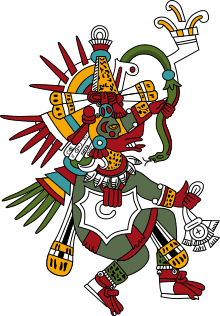Coyolxāuhqui


In Aztec mythology, Coyolxāuhqui (Nahuatl pronunciation: [kojoɬˈʃaːʍki], "Painted with Bells"[1]) was a daughter of the priestess Cōātlīcue ("Serpent Skirt"). She was the leader of her brothers, the Centzon Huitznahuas ("Four Hundred Huiztnaua"), the southern star gods.[1] She led them in attack against their mother, Cōātlīcue, when they learned she was pregnant, convinced she dishonored them all.[2] The pregnant Cōātlīcue miraculously gave birth at the moment of attack to a fully grown and armed Huitzilopochtli. Huitzilopochtli killed his sister, Coyolxāuhqui, and scattered the Centzon Huitxnahuas.[1] There are two major variants of this story, one told in the Codex Duran, and the other in Sahagun's Florentine Codex.[3]
In 1978, workers at an electric company accidentally discovered a large stone relief depicting Coyolxāuhqui in Mexico City. The discovery of the Coyolxāuhqui stone led to a large-scale excavation, directed by Eduardo Matos Moctezuma, to unearth the Templo Mayor.[4]
Attack on Coatlicue
The miraculous pregnancy of Coatlicue, the maternal Earth deity, made her other children embarrassed, including her oldest daughter Coyolxauhqui. As Coatlicue swept the temple, a few hummingbird feathers fell into her chest. Coatlicue’s child Huitzilopochtli sprang from her womb in full war armor and killed Coyolxauhqui and her other 400 brothers, who had been attacking their mother. He cut off her limbs, then tossed her head into the sky where it became the moon, so that his mother would be comforted in seeing her daughter in the sky every night.
Templo Mayor stone disk
A large shield-shaped stone relief reflecting this story was found at the base of the stairs of the Templo Mayor. On this disk, Coyolxauhqui is shown spread out on her side, with her head, arms and legs chopped away from her body. Her position in the stone carving may represent the full moon. But other scholars believe that she should be understood as the Goddess of the Milky Way, or be associated with patterns of other stars[5] associated with Huitzilopochtli. She is distinguished by bells in her hair, a bell symbol on her cheek, and an ear tab showing the Mexica year sign. As with images of her mother, she is shown with a skull tied to her belt. Scholars also believe that the decapitation and destruction of Coyolxauhqui is reflected in the pattern of warrior ritual sacrifice. First, captives’ hearts were cut out. Then the bodies were cast from the temple. At the bottom of the stairs, near the Coyolxauhqui stone, the bodies were decapitated and dismembered.
A replica of the Templo Mayor disk sits on City Terrace Drive in East Los Angeles.
See also
References
- 1 2 3 Townsend, Richard F. (2009). The Aztecs. London: Thames & Hudson. p. 57. ISBN 978-0-500-28791-0.
- ↑ "The Legend of Coatlicue & Coyolxauhqui". Inside Mexico. Retrieved 2015-10-29.
- ↑ Umberger, Emily (Spring 2007). "The Metaphorical Underpinnings of Aztec History: The case of the 1473 civil war". Ancient Mesoamerica. 18: 11–29 – via JSTOR.
- ↑ Townsend, Richard F (2009). The Aztecs. London: Thames & Hudson. p. 149. ISBN 978-0-500-28791-0.
- ↑ The New Tenochtitlan Templo Mayor Coyolxauhqui-Chantico Monument, H. B. Nicholson p 84
- Duran, Fray Diego (Doris Heyden, translator). The History of the Indies of New Spain. University of Oklahoma Press, Norman Oklahoma, 1994.
External links
- In-depth interactive exploring Coyolxauhqui and her story by the J. Paul Getty Museum. Features the Head of Coyolxauhqui, found near the Templo Mayor, Mexico City. Museo Nacional de Antropología
![]()
